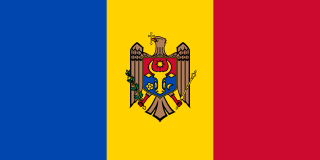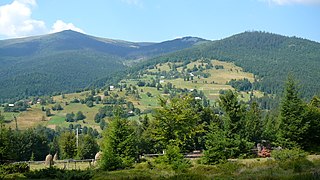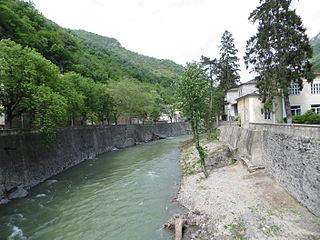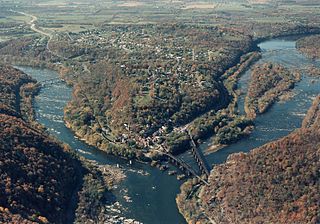
Moldova, officially the Republic of Moldova, is a landlocked country in Eastern Europe, bordered by Romania to the west and Ukraine to the north, east, and south. The capital city is Chișinău.

Romanian is an Eastern Romance language spoken by approximately 24–26 million people as a native language, primarily in Romania and Moldova, and by another 4 million people as a second language. It is an official and national language of Romania and Moldova. In addition, it is also one of the official languages of the European Union.

Transylvania is a historical region which is located in central Romania. Bound on the east and south by its natural borders, the Carpathian mountain range, historical Transylvania extended westward to the Apuseni Mountains. The term sometimes encompasses not only Transylvania proper, but also parts of the historical regions of Crișana and Maramureș, and occasionally the Romanian part of Banat.

Bucharest is the capital and largest city of Romania, as well as its cultural, industrial, and financial centre. It is located in the southeast of the country, at 44°25′57″N26°06′14″E, on the banks of the Dâmbovița River, less than 60 km (37.3 mi) north of the Danube River and the Bulgarian border.

The Carpathian Mountains or Carpathians are a mountain range system forming an arc roughly 1,500 km (932 mi) long across Central and Eastern Europe, making them the third-longest mountain range in Europe after the Ural Mountains with 2,500 km (1,553 mi) and Scandinavian Mountains with 1,700 km (1,056 mi).

Nicolae Ceaușescu was a Romanian communist politician. He was the general secretary of the Romanian Communist Party from 1965 to 1989 and hence the second and last Communist leader of Romania. He was also the country's head of state from 1967, serving as President of the State Council and from 1974 concurrently as President of the Republic until his overthrow in the Romanian Revolution in December 1989, part of a series of anti-Communist and anti-Soviet Union uprisings in Eastern Europe that year.

Cluj-Napoca, commonly known as Cluj, is the fourth most populous city in Romania, and the seat of Cluj County in the northwestern part of the country. Geographically, it is roughly equidistant from Bucharest, Budapest and Belgrade. Located in the Someșul Mic river valley, the city is considered the unofficial capital to the historical province of Transylvania. From 1790 to 1848 and from 1861 to 1867, it was the official capital of the Grand Principality of Transylvania.

The Kingdom of Romania was a constitutional monarchy that existed in Romania from 26 March 1881 with the crowning of prince Karl of Hohenzollern-Sigmaringen as King Carol I, until 1947 with the abdication of King Michael I of Romania, and the Romanian parliament proclaiming Romania a socialist republic.
Following the outbreak of World War II on 1 September 1939, the Kingdom of Romania under King Carol II officially adopted a position of neutrality. However, the rapidly changing situation in Europe during 1940, as well as domestic political upheaval, undermined this stance. Fascist political forces such as the Iron Guard rose in popularity and power, urging an alliance with Nazi Germany and its allies. As the military fortunes of Romania's two main guarantors of territorial integrity—France and Britain—crumbled in the Fall of France, the government of Romania turned to Germany in hopes of a similar guarantee, unaware that the then dominant European power had already granted its consent to Soviet territorial claims in a secret protocol of 1939's Molotov–Ribbentrop Pact.

The Romanians are a Romance ethnic group and nation native to Romania, that share a common Romanian culture, ancestry, and speak the Romanian language, the most widespread spoken Eastern Romance language which is descended from the Latin language. According to the 2011 Romanian census, just under 89% of Romania's citizens identified themselves as ethnic Romanians.

The Romania national football team represents Romania in international football and is controlled by the Romanian Football Federation. They are colloquially known as Tricolorii.

Romania has participated in the Eurovision Song Contest 20 times since its debut in 1994, and has placed in the top ten six times. Its best results were achieved by Luminița Anghel and Sistem in 2005, and by Paula Seling and Ovi in 2010, who both finished in third place. The National Selection, a song contest that takes place every year in Romania, is used to select the country's entrant for that year's Eurovision Song Contest. Its voting system and format have changed over the years.
Bela Reka or Bijela Rijeka, or Bela River or Bijela River may refer to:

The Cerna is a river in Romania, a left tributary of the river Danube. The Cerna has its source on the south-east side of the Godeanu Mountains and flows into the Danube near the town Orșova. The upper reach of the river is sometimes called Cernișoara. With a basin of 1433 square km and a length of 84 km, it carves an erosive tectonic valley with numerous gorges, quite deep sometimes. There is a man-made lake on it (Tierna), just before it crosses the Băile Herculane spa, to perpetuate the old toponimic od Dierna. The upper course of the Cerna is part of the Domogled-Valea Cernei National Park. The Cerna flows through the villages and towns Cerna-Sat, Țațu, Băile Herculane, Pecinișca, Bârza, Topleț, Coramnic and Orșova.
The Ranica is a left tributary of the river Belareca in Romania. It flows into the Belareca in Cornereva.
The Sverdinul Mare is a right tributary of the river Belareca in Romania. It discharges into the Belareca in Mehadia.

The following outline is provided as an overview of and topical guide to Romania:












